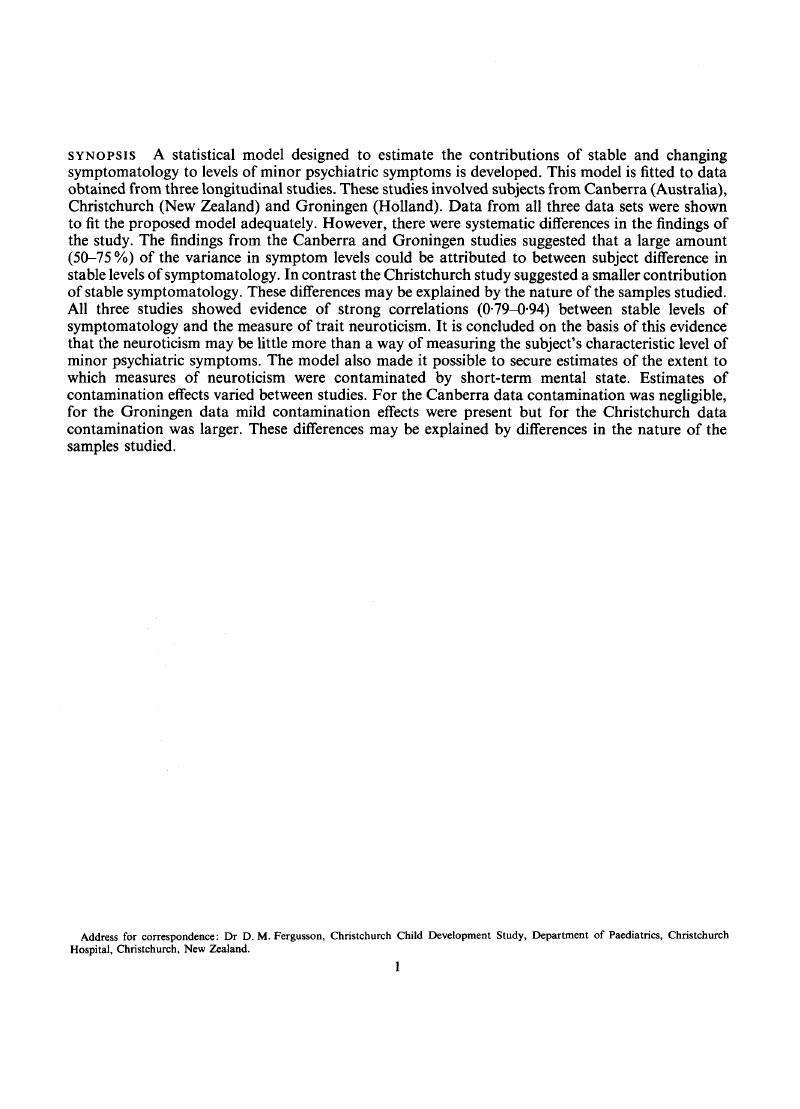Crossref Citations
This article has been cited by the following publications. This list is generated based on data provided by Crossref.
Kendler, K. S.
Silberg, J. L.
Neale, M. C.
Kessler, R. C.
Heath, A. C.
and
Eaves, L. J.
1992.
Genetic and environmental factors in the aetiology of menstrual, premenstrual and neurotic symptoms: a population-based twin study.
Psychological Medicine,
Vol. 22,
Issue. 1,
p.
85.
Engdahl, B. E.
Harkness, A. R.
Eberly, R. E.
Page, W. F.
and
Bielinski, J.
1993.
Structural models of captivity trauma, resilience, and trauma response among former prisoners of war 20 to 40 years after release.
Social Psychiatry and Psychiatric Epidemiology,
Vol. 28,
Issue. 3,
p.
109.
1994.
Sources of individual differences in depressive symptoms: analysis of two samples of twins and their families.
American Journal of Psychiatry,
Vol. 151,
Issue. 11,
p.
1605.
Jorm, A. F.
1995.
The epidemiology of depressive states in the elderly: implications for recognition, intervention and prevention.
Social Psychiatry and Psychiatric Epidemiology,
Vol. 30,
Issue. 2,
p.
53.
Kendler, Kenneth S.
Walters, Ellen E.
Truett, Kim R.
Heath, Andrew C.
Neale, Michael C.
Martin, Nicholas G.
and
Eaves, Lindon J.
1995.
A twin-family study of self-report symptoms of panic-phobia and somatization.
Behavior Genetics,
Vol. 25,
Issue. 6,
p.
499.
Rickwood, D. J.
1995.
The effectiveness of seeking help for coping with personal problems in late adolescence.
Journal of Youth and Adolescence,
Vol. 24,
Issue. 6,
p.
685.
Munton, Anthony G.
and
West, Michael A.
1995.
Innovations and personal change: Patterns of adjustment to relocation.
Journal of Organizational Behavior,
Vol. 16,
Issue. 4,
p.
363.
Ormel, Johan
Lindenberg, Siegwart
Steverink, Nardi
and
Vonkorff, Michael
1997.
Quality of life and social production functions: A framework for understanding health effects.
Social Science & Medicine,
Vol. 45,
Issue. 7,
p.
1051.
Belojevic, G
1997.
Subjective reactions to traffic noise with regard to some personality traits.
Environment International,
Vol. 23,
Issue. 2,
p.
221.
Ormel, Johan
and
Rijsdijk, Frühling V.
2000.
Continuing change in neuroticism during adulthood—structural modelling of a 16-year, 5-wave community study.
Personality and Individual Differences,
Vol. 28,
Issue. 3,
p.
461.
Oldehinkel, Albertine J.
Ormel, Johan
and
Neeleman, Jan
2000.
Predictors of time to remission from depression in primary care patients: Do some people benefit more from positive life change than others?.
Journal of Abnormal Psychology,
Vol. 109,
Issue. 2,
p.
299.
Sato, Tetsuya
Uehara, Toru
Narita, Tomohiro
Sakado, Kaoru
and
Fujii, Yoichiro
2000.
Parental bonding and personality in relation to a lifetime history of depression.
Psychiatry and Clinical Neurosciences,
Vol. 54,
Issue. 2,
p.
121.
von Zerssen, D.
2000.
Psychiatrie der Gegenwart 5.
p.
431.
Neeleman, J.
Ormel, J.
and
Bijl, R. V.
2001.
The Distribution of Psychiatric and Somatic Ill Health: Associations With Personality and Socioeconomic Status.
Psychosomatic Medicine,
Vol. 63,
Issue. 2,
p.
239.
Goldberg, David
2001.
Vulnerability factors for common mental illnesses.
British Journal of Psychiatry,
Vol. 178,
Issue. S40,
p.
s69.
von Zerssen, D.
2001.
Contemporary Psychiatry.
p.
1649.
Miller, Mark W.
2003.
Personality and the etiology and expression of PTSD: A three-factor model perspective..
Clinical Psychology: Science and Practice,
Vol. 10,
Issue. 4,
p.
373.
Agrawal, Arpana
Jacobson, Kristen C.
Gardner, Charles O.
Prescott, Carol A.
and
Kendler, Kenneth S.
2004.
A Population Based Twin Study of Sex Differences in Depressive Symptoms.
Twin Research,
Vol. 7,
Issue. 02,
p.
176.
Gillespie, Nathan A.
Kirk, Katherine M.
Evans, David M.
Heath, Andrew C.
Hickie, Ian B.
and
Martin, Nicholas G.
2004.
Do the Genetic or Environmental Determinants of Anxiety and Depression Change with Age? A Longitudinal Study of Australian Twins.
Twin Research,
Vol. 7,
Issue. 01,
p.
39.
Kuntsi, Jonna
Rijsdijk, Frühling
Ronald, Angelica
Asherson, Philip
and
Plomin, Robert
2005.
Genetic influences on the stability of attention-deficit/hyperactivity disorder symptoms from early to middle childhood.
Biological Psychiatry,
Vol. 57,
Issue. 6,
p.
647.





